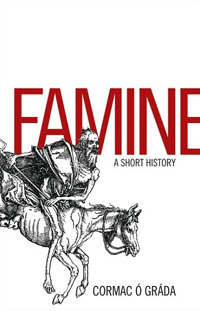The Hunger Historian

Of the infamous quartet of apocalyptic equestrians, Famine seems to be the least studied or, perhaps more accurately, the least visible. Economic historian Cormac Ó Gráda’s Famine: A Short History (Princeton University Press) ameliorates that with a fine balance of storytelling and scholarship. There is no question about the catastrophic effects of famine and mass starvation, but their origins—ecological shocks or political policy—and their severity call for investigation.
Ó Gráda (Black ‘47 and Beyond:The Great Irish Famine in History, Economy, and Memory) extends scrutiny back to the Egyptians for the first recorded famine and transverses the centuries, explicating and elucidating the Great Famine of the Middle Ages, the so-called Irish Potato Famine of 1847, the famines in the Soviet Union in both 1921 – 1922 and 1932 – 1933, the Great Bengal Famine of 1943, the 1959 – 1961 famine in China, Ethiopia in 1984 – 1985, North Korea in 1995 – 1996, and down to Niger in 2005. In its course, this history reviews the work of Malthus and Adam Smith as well as contemporary scholars Mike Davis, Alex de Waal, and Nobel Laureate Amartya Sen. Ó Gráda observes:
It is a great irony that the most deadly famines of the last century—including the worst ever in terms of sheer numbers—occurred under regimes committed, at least on paper, to the eradication of poverty. The history of the USSR (1917 – 1989) is pockmarked by famine. Post-1949 China’s remarkable record of achievements in terms of life expectancy and material progress will always be marred by the Great Leap Forward famine of 1959-61, resulting in the deaths of millions of people. Today, the people of the Democratic Republic of North Korea struggle to survive in the wake of a smaller famine.
For what it is worth he goes on to claim:
prolonged
Which, when you consider it, is a remarkable development.
